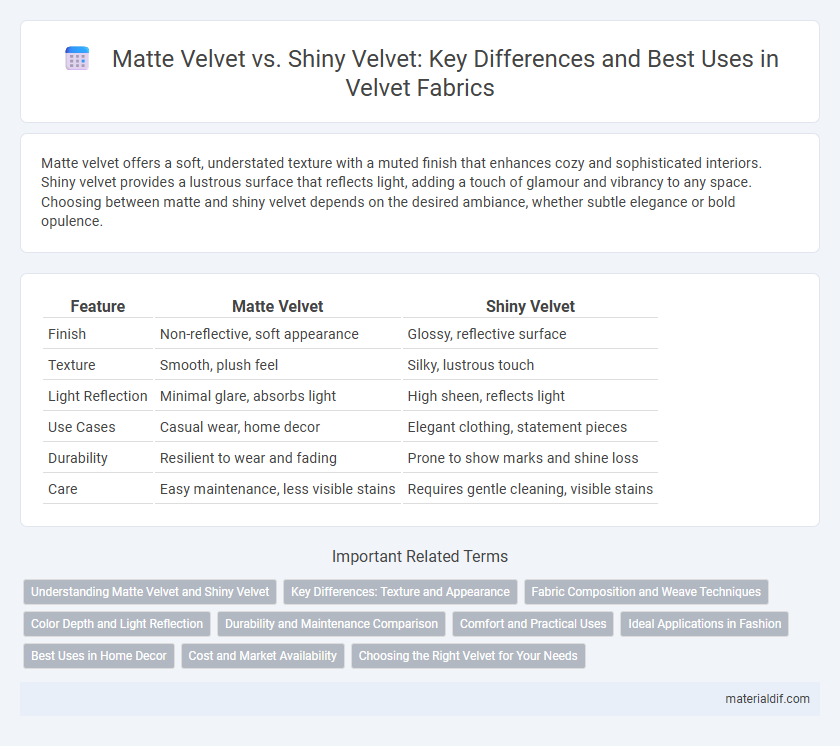Matte velvet offers a soft, understated texture with a muted finish that enhances cozy and sophisticated interiors. Shiny velvet provides a lustrous surface that reflects light, adding a touch of glamour and vibrancy to any space. Choosing between matte and shiny velvet depends on the desired ambiance, whether subtle elegance or bold opulence.
Table of Comparison
| Feature | Matte Velvet | Shiny Velvet |
|---|---|---|
| Finish | Non-reflective, soft appearance | Glossy, reflective surface |
| Texture | Smooth, plush feel | Silky, lustrous touch |
| Light Reflection | Minimal glare, absorbs light | High sheen, reflects light |
| Use Cases | Casual wear, home decor | Elegant clothing, statement pieces |
| Durability | Resilient to wear and fading | Prone to show marks and shine loss |
| Care | Easy maintenance, less visible stains | Requires gentle cleaning, visible stains |
Understanding Matte Velvet and Shiny Velvet
Matte velvet features a soft, muted finish that absorbs light, creating a sophisticated and understated texture ideal for classic interior designs and elegant apparel. Shiny velvet reflects light with a lustrous sheen, offering a vibrant and luxurious appearance that enhances statement pieces and modern decor. Understanding these differences helps in selecting the right velvet type for specific aesthetic and functional applications in fashion and home textiles.
Key Differences: Texture and Appearance
Matte velvet features a soft, muted texture that absorbs light, creating a subtle, elegant finish often preferred for understated designs. Shiny velvet reflects light with a lustrous sheen, showcasing a more vibrant and luxurious appearance ideal for statement pieces or formal attire. The key difference lies in their tactile feel and visual impact, with matte velvet offering a cozy matte surface and shiny velvet providing a glossy, reflective look.
Fabric Composition and Weave Techniques
Matte velvet typically features a dense pile with a shorter, tightly woven surface created using a cut pile weave, often composed of cotton or polyester blends that enhance its muted, soft finish. Shiny velvet, on the other hand, incorporates silk or rayon fibers with a looser, longer pile weave that reflects light more vividly, resulting in a lustrous, glossy appearance. The weave technique in shiny velvet maximizes light reflection through a smooth, reflective yarn arrangement, while matte velvet's compact weave minimizes sheen for a subtle texture.
Color Depth and Light Reflection
Matte velvet exhibits deeper, richer color depth due to its low light reflection, absorbing light and emphasizing texture. Shiny velvet reflects more light, creating a lustrous, vibrant appearance that enhances color brightness but can diminish perceived depth. Choosing between the two depends on the desired interplay of light and color intensity in interior design or fashion applications.
Durability and Maintenance Comparison
Matte velvet offers greater durability due to its tightly woven fibers, which resist wear and tear better than shiny velvet's lustrous finish that is more prone to snagging and discoloration. Maintenance for matte velvet is generally easier, requiring less frequent cleaning to maintain its subtle texture, while shiny velvet demands careful handling to preserve its reflective sheen and avoid visible stains. Choosing matte velvet ensures a longer lifespan and simplified upkeep, making it ideal for high-traffic areas or everyday use.
Comfort and Practical Uses
Matte velvet offers a soft, breathable texture that enhances comfort, making it ideal for cozy upholstery and everyday apparel. Shiny velvet features a smooth, lustrous finish that adds elegance but can feel less breathable and may require careful handling to maintain its sheen. Practical uses of matte velvet include casual furniture and durable clothing, while shiny velvet suits formal wear and decorative accents where visual appeal is prioritized.
Ideal Applications in Fashion
Matte velvet offers a rich, understated texture ideal for elegant evening wear and tailored suits, providing a sophisticated, muted allure that suits minimalist fashion. Shiny velvet captures light with its lustrous finish, making it perfect for statement pieces like cocktail dresses and theatrical costumes where vibrancy and glamour are desired. Designers often choose matte velvet for autumn and winter collections due to its warmth and depth, while shiny velvet thrives in spring and summer lines for its reflective and eye-catching appeal.
Best Uses in Home Decor
Matte velvet offers a soft, understated elegance ideal for cozy living rooms and bedrooms, enhancing warmth without reflecting light, making it perfect for upholstery and drapery in spaces with softer lighting. Shiny velvet, with its lustrous finish, creates a bold, glamorous statement suited for accent pieces like throw pillows and ottomans, adding visual interest and depth in well-lit areas such as formal dining rooms or luxury lounges. Choosing matte velvet supports a subtle, tactile comfort atmosphere, while shiny velvet excels in creating vibrant focal points and sophisticated contrasts in home decor.
Cost and Market Availability
Matte velvet typically costs less than shiny velvet due to simpler finishing processes and lower demand in high-end fashion markets. Shiny velvet commands higher prices, driven by its luxurious appearance and popularity in upscale apparel and home decor. Market availability favors matte velvet for large-scale manufacturing, while shiny velvet remains more niche, often found in specialty boutiques and premium retail outlets.
Choosing the Right Velvet for Your Needs
Matte velvet offers a subtle, understated look with a soft texture that absorbs light, making it ideal for cozy interiors and elegant upholstery. Shiny velvet reflects light with a lustrous finish, adding a glamorous touch perfect for fashion, drapery, and statement pieces. Choosing between matte and shiny velvet depends on the desired ambiance, durability needs, and maintenance preferences.
Matte Velvet vs Shiny Velvet Infographic

 materialdif.com
materialdif.com